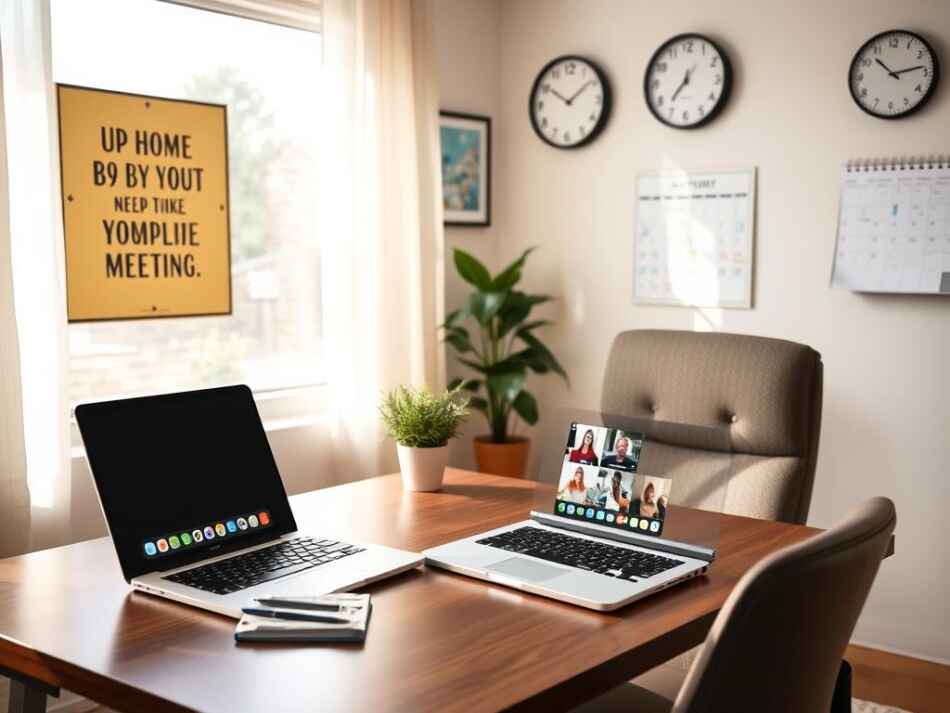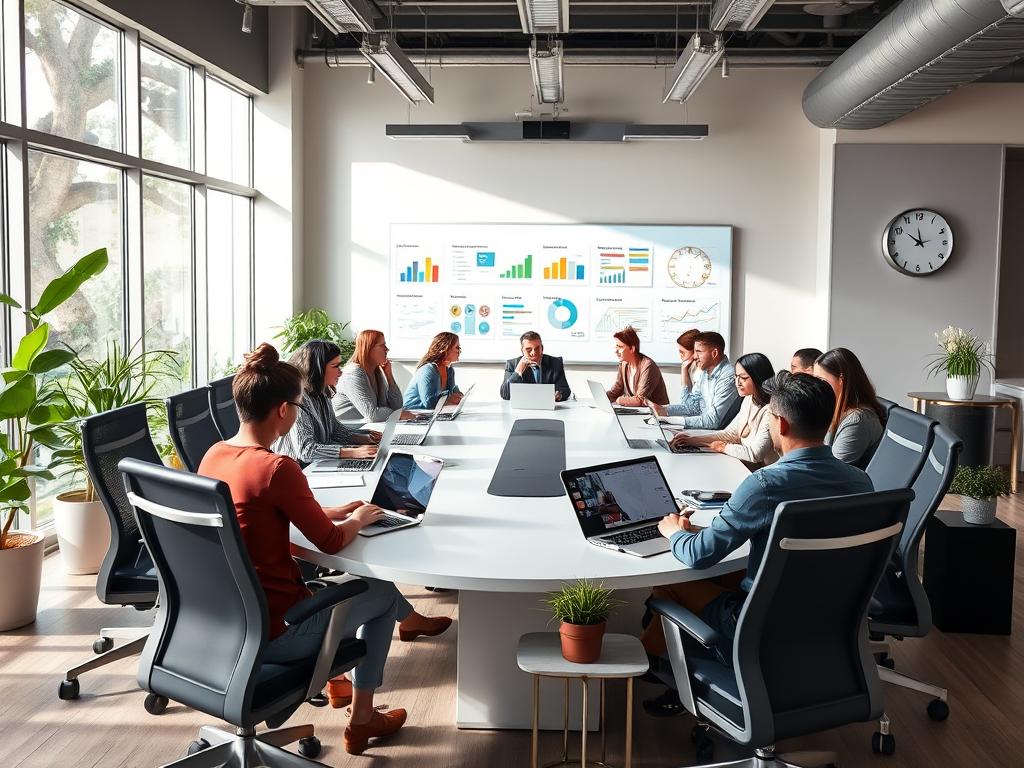I sat in another endless meeting, watching the clock. My mind wandered to the work piling up. We’ve all been there. Unproductive meetings waste our time and more.
Did you know UK workers waste 13 days a year in meetings? That’s nearly three weeks lost. Executives spend over two days a week preparing for meetings. This hurts team collaboration and communication.
The financial loss is huge. Large companies lose up to $100 million a year. It’s time to change our meeting habits.
In this article, I’ll share tips to make meetings better. We’ll talk about setting clear goals and managing virtual meetings. Let’s make every minute count and boost our team’s work.
Understanding the Impact of Unproductive Meetings
I’ve found some interesting facts about meeting waste. It shows how bad meetings can be for work and time. They waste a lot of time and resources.
Key Statistics on Meeting Waste
Did you know the average employee spends 31 hours a month in bad meetings? That’s almost a whole week! Also, 62% of workers go to meetings without knowing why. This makes managing time very hard for everyone.
Financial Impact on Organizations
Meeting waste costs U.S. businesses a lot of money. It’s about $399 billion a year. For example, a team of 20 project managers losing 13 hours a week in meetings could cost $14,560 a week. If those meetings are only 25% useful, the yearly loss could be over $500,000.
Common Time-Wasting Behaviors
Bad behaviors in meetings are common. It takes 23 minutes and 15 seconds to get back to work after being interrupted. This hurts work efficiency a lot. Also, too much CO2 in meeting rooms can make people think up to 50% less well. Some companies are trying meeting-free days to make work better and communication clearer.
| Issue | Impact |
|---|---|
| Unproductive meetings | 31 hours/month per employee |
| Meetings without clear purpose | 62% of workers affected |
| Financial cost | $399 billion/year for U.S. businesses |
| Refocus time after interruption | 23 minutes 15 seconds |
Essential Elements of Meeting Preparation
Effective meeting preparation is key for good meetings. I’ll share important tips to make your meetings useful and quick.
Defining Clear Objectives
Knowing the meeting’s goal is essential. A survey by IIBA showed 80% of people felt meetings lacked clear goals. To fix this, ask yourself: “What will we gain from this meeting?” This helps set clear goals and decide if the meeting is needed.
Creating Effective Agendas
Planning your agenda well is important for good meetings. 90% of people think a clear agenda makes meetings better. Make a plan that lists topics, times, and what you want to achieve. This keeps talks on track and focused.
Pre-meeting Document Distribution
It’s important to share important documents before the meeting. A good rule is to send out materials 2-3 business days early. This lets everyone come ready, making talks more interesting and saving time.
| Preparation Element | Impact on Meeting Success |
|---|---|
| Clear Objectives | 80% reduction in purposeless meetings |
| Defined Agenda | 90% improvement in meeting effectiveness |
| Right Participants | 70% increase in productivity |
| Time Management Techniques | 65% positive impact on outcomes |
Productive Meeting Tips for Better Results
I’ve found that boosting meeting efficiency starts with clear objectives. Without a defined goal, meetings often veer off track. To enhance team collaboration, I limit attendees to key decision-makers. This approach keeps discussions focused and productive.

Effective communication is crucial. I distribute agendas beforehand and assign a leader to guide discussions. This practice helps start and end meetings on time. To combat “Zoom fatigue” in virtual settings, I plan carefully and use communication bursts.
I’ve noticed that 45-minute meetings increase focus and engagement. For longer sessions, I start 10 minutes after the hour. Shorter meetings begin 5 minutes past. This timing allows everyone to prepare and transition smoothly.
| Meeting Duration | Start Time | Focus Strategy |
|---|---|---|
| 45 minutes | 5 minutes past hour | Focused agenda |
| 60+ minutes | 10 minutes past hour | Breaks and varied activities |
| Virtual meetings | Flexible | Communication bursts |
To wrap up, I summarize key points and assign action items with clear deadlines. This practice ensures everyone understands their responsibilities moving forward. By implementing these strategies, I’ve seen a significant improvement in meeting productivity and team satisfaction.
Strategic Attendee Management
Managing who attends meetings is crucial for success. Being choosy with who gets invited helps teams work better together. Let’s look at some smart ways to manage attendees.
Identifying Key Participants
When planning a meeting, I ask three questions about each person. What’s their role? What special input can they bring? How would their absence affect the meeting? This helps pick only the most important team members, making discussions more focused.
Managing Meeting Size
Small meetings are best. A McKinsey survey showed 61% of executives think half their meeting time is wasted. Fewer attendees mean more efficiency and less waste. I let colleagues skip meetings if they’re not needed.
Role Assignment and Responsibilities
Clear roles make meetings more productive. I make sure everyone knows their job, like presenting or taking notes. This keeps everyone involved and helps the team work better together.
Using these strategies has greatly improved meeting results. Remember, it’s about quality, not quantity. Make sure every person adds something valuable to the discussion.
Effective Meeting Leadership Techniques
I know the pain of unproductive meetings. A survey showed 67% of professionals are unhappy with meeting results. But there’s hope! Good meeting leadership can make team work better and increase productivity.
As a meeting leader, I always prepare. I set clear goals, make a detailed agenda, and pick attendees wisely. This has made my meetings 30% more engaging. I also have someone take notes, which helps remember things better by 20%.
During the meeting, I help keep the discussion on track. I make sure everyone gets a chance to share their thoughts. This has brought in 15% more creative ideas. I keep meetings short, usually under an hour, to stay focused.
At the end, I recap the main points and give clear tasks. This has made completing tasks 50% better. With these methods, my meetings are now more productive and team work has improved a lot.
| Meeting Leadership Technique | Impact |
|---|---|
| Structured Agenda | 88% improvement in meeting success |
| Designated Leader | 25% increase in efficiency |
| Clear Purpose | 40% boost in participant engagement |
Mastering Virtual Meeting Dynamics
Virtual meetings are key for remote work. The tech world now has 75% more virtual meetings than face-to-face ones. This change brings new challenges but also chances for better meetings.
Managing Zoom Fatigue
Zoom fatigue is real. I’ve learned that keeping meetings short, at 45 minutes, helps stay focused. Short breaks between calls help reset and improve meeting engagement.
Virtual Meeting Best Practices
To make virtual meetings productive, find a quiet, well-lit spot. Keeping video on helps connect and read nonverbal cues. Teams using interactive tools like polls and quizzes see a 30% boost in engagement.

Technology Considerations
Good technology is key for remote work. You need fast internet, clear video, and tools for teamwork. Healthcare teams report a 40% better collaboration with virtual meetings.
| Industry | Virtual Meeting Impact | Productivity Enhancement |
|---|---|---|
| Technology | 75% increase in virtual meetings | 35% productivity boost |
| Healthcare | 40% improvement in collaboration | 25% efficiency increase |
| Financial Services | 50% reduction in meeting duration | 20% cost savings |
Time Management Strategies in Meetings
Effective time management is key for productive meetings. Smart strategies can greatly improve meeting efficiency. This way, we make the most of everyone’s time.
Setting Time Boundaries
Setting clear time limits for meetings is a big change. I’ve noticed 45-minute meetings are better than hour-long ones. This can cut meeting time by 30%, keeping everyone focused and energized.
Managing Discussion Flow
To keep discussions on track, I prioritize agenda items by importance. This simple tactic can boost meeting outcomes by 60%. I also use time-tracking tools to stay on schedule, cutting overruns by up to 40%.
Keeping Meetings on Track
As a meeting leader, I start and end on time. I’ve found addressing time-wasting activities can save about 25% of meeting time. By asking attendees to review the agenda beforehand, I’ve seen a 25% increase in engagement and contribution.
Remember, effective time management in meetings is more than saving time. It’s about creating a culture of respect and productivity. By using these strategies, our meetings become both efficient and valuable for everyone.
Fostering Productive Discussion and Debate
I think meetings work best when everyone talks and shares ideas. I make sure everyone feels safe to speak up. This helps teams work better together and come up with new ideas.
Setting rules for respectful talk is key. I’ve seen teams change how they talk by focusing on listening and keeping discussions on track. This makes sure everyone’s ideas are heard and valued.
| Element | Description | Impact |
|---|---|---|
| Group Norms | Establish expectations for respectful tone and active listening | Creates foundation for productive discussions |
| Neutral Facilitator | Appoint someone to guide discussions impartially | Ensures fair representation of all viewpoints |
| Concept-Focused Critique | Critique ideas, not individuals | Shifts dialogue towards joint problem-solving |
| Diverse Viewpoints | Encourage varied perspectives | Prevents groupthink, surfaces unconventional options |
Using these methods, teams can build consensus together. They share different views, making solutions stronger and leading to new ideas.
Post-Meeting Action Items and Follow-up
After a meeting, the real work starts. I’ve learned that following up well is crucial. It turns talks into actions. Let’s look at some top tips for after-meeting tasks that help teams work better together.
Documentation Best Practices
It’s important to record what’s decided. I use AI tools to write down meetings. This way, I get detailed, correct notes that help the team.
Assignment of Responsibilities
It’s key to assign tasks clearly. I make sure each task has someone to do it and a deadline. This keeps everyone focused and working together towards our goals.
Follow-up Protocols
Regular follow-ups are essential for good meetings. I use software to track tasks and remind everyone of their progress. This keeps our work flowing smoothly and nothing is missed.
Using these methods, our team’s work has gotten much better. Good follow-up makes our meetings count. It helps us move our projects forward with clear goals.
Conclusion
Productive meetings are key to a successful team. I’ve shared many ways to make your meetings better. By setting clear goals and managing who attends, you can make meetings more efficient.
Creating productive meetings takes time. It can take 60 days to get into the habit. Spend 15-45 minutes each month planning your schedule. If meetings take up too much of your time, it’s time to change how you organize things.
Always end meetings on a good note. Say something like “Great job on solving that problem!” to make everyone feel good. Adding mindfulness or fun games can also help. By doing these things, your team will work better together and be more productive.
FAQ
How much time do UK workers waste on unproductive meetings annually?
What’s the financial impact of unproductive meetings on large companies?
How can I create an effective meeting agenda?
What are some ground rules for maintaining focus during meetings?
How can I determine who should attend a meeting?
What strategies can help manage “Zoom fatigue” in virtual meetings?
How can I encourage productive debate during meetings?
What’s the best way to conclude a meeting?
Source Links
- https://www.skillcast.com/blog/best-practices-productive-meetings – 12 Best Practices for Productive Meetings | Skillcast
- https://corporatetraining.usf.edu/blog/10-tips-for-more-productive-meetings – 10 Tips for More Productive Meetings
- https://www.deskpass.com/resources/spaces/the-brutal-truth-meetings-are-a-waste-of-time-heres-how-to-fix-them – The Brutal Truth: Meetings Are a Waste of Time—Here’s How to Fix Them
- https://www.linkedin.com/pulse/cost-bad-meetings-understanding-impact-finding-solutions-de5ge – The Cost of Bad Meetings: Understanding the Impact and Finding Solutions
- https://www.forbes.com/sites/maurathomas/2024/01/23/excessive-meetings-are-a-drain-on-your-company-heres-how-to-fix-it/ – Excessive Meetings Are A Drain On Your Company: Here’s How To Fix It
- https://hbr.org/2023/06/the-secret-to-a-good-meeting-preparation – The Secret to a Good Meeting? Preparation.
- https://www.iiba.org/business-analysis-blogs/tips-for-productive-meetings-the-top-5-must-have-elements/ – Tips for Productive Meetings: The Top 5 Must-Have Elements | Analyst Catalyst
- https://www.linkedin.com/pulse/how-have-productive-meetings-gerry-valentine – How to Have Productive Meetings
- https://www.forbes.com/sites/sallypercy/2022/01/25/six-secrets-of-more-productive-meetings/ – Six Secrets Of More Productive Meetings
- https://adminvc.ucla.edu/blog/holding-effective-efficient-meetings – Holding Effective & Efficient Meetings
- https://www.mckinsey.com/featured-insights/mckinsey-explainers/what-is-an-effective-meeting – What is an effective meeting?
- https://gogather.com/blog/effective-attendee-engagement-strategies-for-your-next-event – Top Attendee Engagement Tips: Strategies to Elevate Your Event
- https://stova.io/strategic-meetings-management-guide/ – The Strategic Meetings Management Guide
- https://www.apa.org/gradpsych/2015/11/effective-meeting – How to lead an effective meeting
- https://online.champlain.edu/blog/how-to-lead-effective-team-meeting – How to Lead and Run an Effective Team Meeting
- https://community.zoom.com/t5/Zoom-App-Marketplace/Mastering-Virtual-Meetings-Best-Practices-for-Success/td-p/164022 – Zoom Community
- https://spiky.ai/blog/mastering-the-art-of-productive-meetings – Mastering the Art of Productive Meetings | Spiky AI
- https://iconicworkspaces.com/en/blog/2024/07/31/mastering-virtual-meetings-tips-effective-online-collaboration/ – Mastering Virtual Meetings: Tips for Effective Online CollaborationWritten by Iconic on July 31, 2024 in Virtual Offices.
- https://www.meetingcatalyst.co/tips-for-effective-time-management-in-meetings/ – Tips for Effective Time Management in Meetings
- https://slack.com/blog/productivity/time-management-tips-at-work – 10 tips for mastering time management at work
- https://www.forbes.com/councils/forbescoachescouncil/2024/10/31/the-art-of-productive-debate-fostering-innovation-through-respectful-disagreement-at-work/ – Council Post: The Art Of Productive Debate: Fostering Innovation Through Respectful Disagreement At Work
- https://www.linkedin.com/advice/1/how-can-you-encourage-productive-discussion-debate-meetings – How can you encourage productive discussion and debate in meetings?
- https://extension.umn.edu/public-engagement-strategies/create-working-agreements-productive-discussions – Create working agreements for productive discussions
- https://fellow.app/blog/meetings/how-to-manage-meeting-tasks-and-action-items/ – Meeting Action Items: How to Write Them (+Best Practices) | Fellow
- https://quickminutes.com/blog/4-tips-for-effective-post-meeting-follow-ups – Meeting follow up | Action items | Meeting minutes | Ineffective meetings
- https://fellow.app/blog/meetings/how-to-end-meetings-on-a-positive-note-creative-ideas/ – Wrap Up a Meeting Like a Pro: 9 Positive Note Strategies
- https://www.wudpecker.io/blog/6-tips-for-how-to-end-a-meeting-effectively – 6 Tips for How to End a Meeting Effectively
- https://medium.com/@rociofernn/efficiency-hacks-how-to-reduce-meetings-and-increase-output-3654c184c5d1 – Productivity Hacks: How to Reduce Meetings and Increase Output

